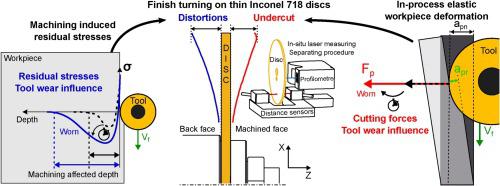Journal of Manufacturing Processes ( IF 6.1 ) Pub Date : 2020-11-19 , DOI: 10.1016/j.jmapro.2020.11.007 Bastien Toubhans , Fabien Viprey , Guillaume Fromentin , Habib Karaouni , Théo Dorlin

|
Machining thin workpieces is a challenging task as geometrical errors may result from the combination of several phenomena. Among these, elastic workpiece deformation and machining induced residual stresses may be predominant sources due to low part stiffness. There is a lack of studies trying to quantify the influence of machining induced residual stresses on the total geometrical errors. A thorough experimental methodology is developed to quantify the influence of both phenomena separately by comparing the workpiece shape and dimensions, in-situ, before and after machining, using laser sensors. The proposed methodology can also be used to quantify the geometrical errors linked to clamping or stress rebalancing following material removal. The case study is the finish turning of thin Inconel 718 workpieces using carbide tools. In the studied case, machining induced residual stresses are responsible for 3–32 % of the total geometrical errors depending on tool wear and cutting parameters.
中文翻译:

研究旋转Inconel 718薄工件时零件变形的现象
加工薄工件是一项艰巨的任务,因为几种现象的结合可能导致几何误差。其中,由于零件刚度低,弹性工件变形和加工引起的残余应力可能是主要来源。缺乏研究来量化加工引起的残余应力对总几何误差的影响。通过在原位比较工件形状和尺寸,开发了一种全面的实验方法来分别量化两种现象的影响,在加工前后,使用激光传感器。所提出的方法还可以用于量化与去除材料后的夹紧或应力再平衡有关的几何误差。案例研究是使用硬质合金刀具对Inconel 718薄工件进行精加工。在所研究的情况下,取决于刀具的磨损和切削参数,加工引起的残余应力占总几何误差的3–32%。







































 京公网安备 11010802027423号
京公网安备 11010802027423号